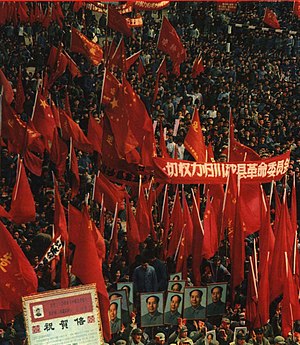| January Storm | |||
|---|---|---|---|
| Part of the Cultural Revolution | |||
 The formation of the Chuansha County Revolutionary Committee at Shanghai, c. May 1967. | |||
| Date | 5 January – 23 February 1967 (49 days) | ||
| Location | |||
| Caused by | Rising radicalism of the Cultural Revolution | ||
| Goals | Seizure of political power in Shanghai | ||
| Resulted in | Coup successful:
| ||
| Parties | |||
| |||
| Lead figures | |||
Supported by:
Supported by:
No centralized leadership | |||
| January Storm | |||||||||||||
|---|---|---|---|---|---|---|---|---|---|---|---|---|---|
| Simplified Chinese | 一月风暴 | ||||||||||||
| Traditional Chinese | 一月風暴 | ||||||||||||
| Literal meaning | "January Storm" | ||||||||||||
| |||||||||||||
| Formal name | |||||||||||||
| Simplified Chinese | 一月革命 | ||||||||||||
| Traditional Chinese | 一月革命 | ||||||||||||
| Literal meaning | "January Revolution" | ||||||||||||
| |||||||||||||
The January Storm, formally known as the January Revolution, was a coup d'état in Shanghai that occurred during the Cultural Revolution in between 5 January to 23 February 1967. The coup, precipitated by the Sixteen Articles and unexpected local resistance towards Maoism in Shanghai, was launched by Maoist rebel factions towards the city's party leadership under the directives of the Cultural Revolution Group (CRG) through Maoist leaders such as Zhang Chunqiao, Wang Hongwen and Yao Wenyuan, with backing from Mao Zedong, Kang Sheng, and Jiang Qing. The coup culminated in the overthrow of the Shanghai Municipal Committee of Chen Pixian, Wei Wenbo and Cao Diqiu, and led to the creation of the Shanghai People's Commune on 5 February 1967.[1]
Modeled after the Paris Commune, the CRG leaders in Shanghai planned to introduce direct democracy for the city's new leadership, but the nature of its implementation generated severe opposition among the Chinese Communist Party (CCP)'s top echelons, who viewed it as a potential threat towards the Central Committee and State Council grip of power on China's domestic affairs. Meanwhile, the political instability from seizure of powers and rise of violence through violent struggles between rebel factions alarmed top generals of the People's Liberation Army, resulting in joint efforts by several CCP veterans to resist the radicalism of the Cultural Revolution in the February Countercurrent. Ultimately, the commune collapsed within 18 days after Mao Zedong retracted his support, and was reformed under a revolutionary committee jointly administered by a "triple alliance" of military personnel, revolutionary cadres, and the revolutionary masses.
Although the commune in Shanghai ended in failure, it was influential in inspiring rebel factions throughout China to form revolutionary committees of their own, which eventually started a series of seizure of powers that led to armed violent struggles nationwide throughout 1967, effectively marking a new and more violent stage in the Cultural Revolution.[2][3]
